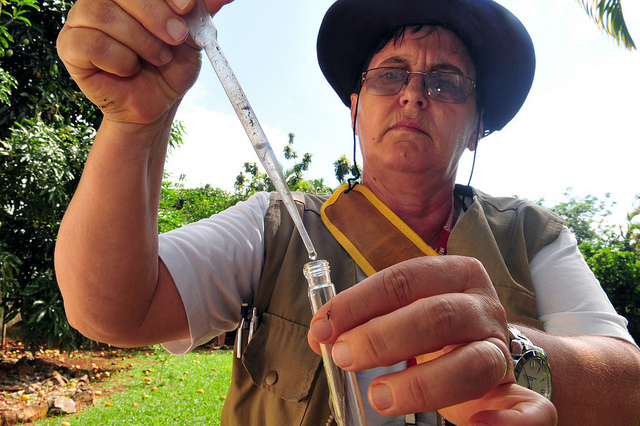The microcephaly now reportedly affecting thousands of babies in Brazil, which the media have attributed to the mosquito-borne Zika virus, may not be caused by a virus after all. According to reports from a group of Argentinian doctors called Physicians in Crop-Sprayed Towns (PCST), a chemical called pyriproxyfen — which has been introduced to drinking water in mosquito-ridden areas of Brazil to cause deadly mutations in mosquito larvae — may be the real cause of the birth defect.
In 2014, there were 147 cases of microcephaly reported in Brazil. That year, the Brazilian government began putting the larvicide into drinking water in Pernambuco, the state now reporting 35% of Brazil’s 4000 new microcephaly cases.
The PCST doctors say that previous outbreaks of Zika that infected up to 75% of the population in affected countries did not show a spike in microcephaly cases. PCST (and the New York Times) note that in Colombia, none of more than 3000 pregnant women reported to be infected with the virus has given birth to an infant with microcephaly.
Zika has lately spread to 250 cities and towns in Colombia, but there has been no surge in cases of the birth defect. According to the Times, in Cúcuta, a city of 650,000 “that sits squarely in the range of the mosquitos that transmit the virus . . . it is difficult to find a person who has not had Zika or known someone who did. Entire families have come down with the symptoms.” At the main hospital, 80 pregnant women have sought treatment for the virus and have been offered abortions in the event that birth defects are detected in utero (abortion is legal in Colombia), but so far, the hospital has not performed any abortions on Zika-infected women.
Colombia’s Deputy Health Minister is quoted in the Times as saying, “There’s a lot we don’t know about this disease. What we know is there’s a growing disparity between what we’re seeing in Colombia with Zika and the experience in Brazil.”
The World Health Organization, while initiating new efforts to halt the spread of the virus, has stated that the link between Zika and the birth defect has yet to be established. The Times says “the scientific link between between Zika and microcepahy in infants has not been proved,” though international health officials say the link is “strongly suspected.” Similarly, Dr. Patricia Pestana Garcez, who researches microcephaly at the Federal University of Rio de Janeiro said “there is no direct evidence that the virus causes microcephaly” but advised that circumstantial evidence indicated people shouldn’t take chances.
Meanwhile, according to the Washington Post, many of the cases of microcephaly reported in Brazil may not be microcephaly or may not be linked to Zika. Britain’s Daily Telegraph notes that “the country has registered a total of 3,852 suspected cases [of microcephaly], but of the roughly 1,200 investigated so far, just 462 have been confirmed. Evidence of Zika infection was found in just 41 of the affected babies.”
A report issued in early February by an organization of public health workers called the Brazilian Association of Collective Health (ABRASCO) reads as follows.
In 2014 a new larvicide, pyriproxyfen, was introduced to the drinking water. . . . This larvicide is a juvenile hormone analogue or juvenoid, with the mechanism of inhibiting the development of insect adult characteristics. . . . [Potential] damage to the environment and human health arising from the use of chemicals in vector control has not been properly studied or revealed to vulnerable populations [or to] public health workers. . . . The organophosphate insecticide temephos . . . was introduced in Brazil in 1968 as a larvicide in drinking water, especially in the North and Northeast of Brazil. Its impacts on people’s health has not been studied. We know that despite the fact that the mosquitos had resistance to it, it continued to be used until it ran out . . . despite abundant toxicological information about it concerning potential risks to human health.
Virtually all of the mainstream media take it as proven that the birth defect is caused by the mosquito, and concentrate on reporting multi-national, multi-agency efforts to develop a Zika vaccine or breed Zika-free mosquitos. It appears that only doctors and public health workers on the ground are demanding that the chemical be investigated.
Given that a common cause of microcephaly is chemical — drug and alcohol abuse in pregnancy — the pesticide-laced drinking water seems at least worthy of study.
Though Monsanto-affiliate Sumimoto Chemical claims in its literature that pyriproxyfen poses little risk to birds, fish, and mammals, it notes that the chemical is a “teratogenic” (i.e., it works by causing birth defects).
Brazilian and Argentinian doctors are challenging the Brazilian government’s rush to blame the virus; meanwhile the government of Grande do Sul in southern Brazil has stopped using the chemical.
The PCST doctors suggest that the Brazilian government has rejected “the hypothesis of direct and cumulative chemical damage caused by years of endocrine and immunological disruption of the affected population” in order to deflect blame from its water treatment program.
So is it the pest or the pesticide? Time will tell.
Sources
https://www.washingtonpost.com/news/worldviews/wp/2016/01/29/brazil-may-have-fewer-zika-related-microcephaly-cases-than-previously-reported/
http://www.japantimes.co.jp/opinion/2016/02/11/commentary/world-commentary/microcephaly-caused-zika-pesticides/#.VsKSV5MrLow
http://thefreethoughtproject.com/doctors-groups-deny-microcephaly-zika-connection-blame-monsanto-linked-pesticide-birth-defects/
“It’s Not the Zika Virus” — Doctors Expose Monsanto Linked Pesticide as Cause of Birth Defects
by u/Mike_Rubin in conspiracy
http://www.techtimes.com/articles/133548/20160214/monsanto-larvicide-not-zika-virus-true-cause-of-brazils-microcephaly-outbreak-doctors.htm
Image by Agência Brasília, courtesy of Creative Commons license.













